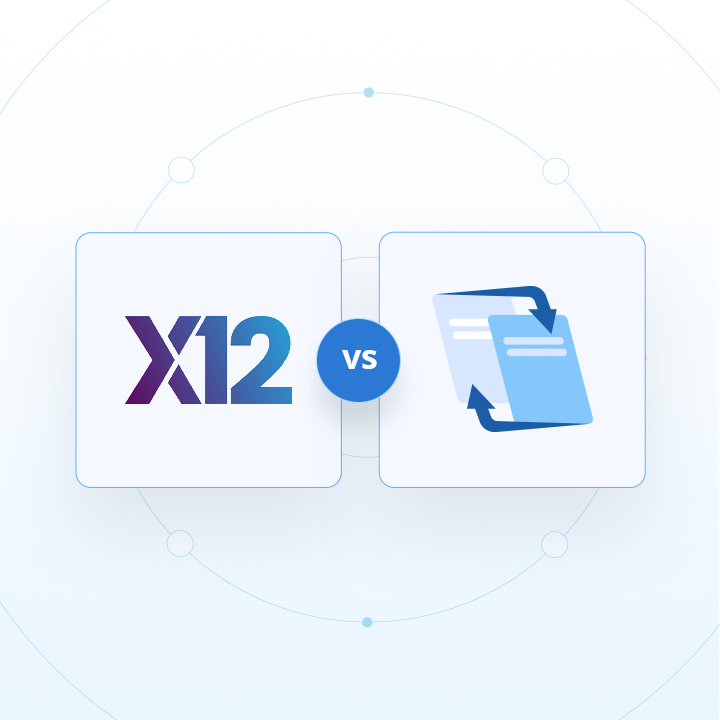
ANSI X12 vs EDIFACT: Key Differences
Electronic Data Interchange (EDI) is a popular communication method that enterprises use to exchange information accurately and quickly with trading partners. EDI transmits data almost instantaneously — serving as a fast and efficient mode for exchanging business documents.
ANSI X12 vs. EDIFACT are the two most common EDI standards used for EDI, but they have different structures, styles, and usage. This blog will discuss the differences between X12 and EDIFACT and how a no-code EDI solution can help streamline your EDI processes.
What Is EDIFACT?
EDIFACT is a global EDI standard developed by the United Nations. It’s widely used internationally — particularly in Europe — for international trade across different sectors. EDIFACT has a structured format for business messages with six-character alphanumeric codes (e.g., ORDERS for purchase orders).
What is ANSI X12?
ANSI X12 is an EDI standard developed by the American National Standards Institute (ANSI). It’s primarily used in North America for various industries, such as retail, healthcare, and logistics. ANSI X12 has a structured format for business documents with three-digit numeric codes (e.g., 850 for purchase orders).

ANSI X12 vs. EDIFACT: Key Differences
The primary difference between EDIFACT and X12 lies in how their transaction sets are structured, the document style they use, the geographic region where they are used, and the terminators (or separators) they use. Here’s a more detailed comparison:
Structure
ANSI X12 uses a hierarchical structure of segments and elements, each identified by a unique identifier. Transaction sets consist of segments grouped in a predefined order.
EDIFACT also uses a hierarchical structure but is more flexible. Messages are composed of segments, which are divided into data elements, allowing more comprehensive descriptions.
Document Style
ANSI X12 transaction sets are identified by three-digit numeric codes (e.g., 850 for purchase orders and 810 for invoices).
On the other hand, EDIFACT messages are identified by six-character alphanumeric codes (e.g., ORDERS for purchase orders, INVOIC for invoices).
Geography
ANSI X12 is predominantly used in North America, especially in the United States and Canada.
In contrast, EDIFACT is widely used internationally, especially in Europe and other regions involved in global trade.
Security
ANSI X12 supports various security measures, including encryption and secure transmission protocols, but often relies on the security measures of the transmission medium. It supports ASC X12.58 – Security Structures.
EDIFACT, similar to ANSI X12, supports encryption and secure protocols. It also includes provisions for secure authentication and non-repudiation (a user cannot deny having performed a transaction) in some implementations. It supports the following:
- ISO 9735-5 – Security rules for batch EDI
- ISO 9735-6 – Secure authentication and acknowledgment message
- ISO 9735-7 – Security rules for batch EDI
- ISO 9735-9 – Security key and certificate management message
Terminators/Separators
ANSI X12 uses specific characters to separate data elements (typically ‘*’), segments (typically ‘~’), and sub-elements (typically ‘:’).
EDIFACT uses different characters, typically “+” for segment terminators, “:” for element separators, and”’” for message terminators. This flexibility allows for customization to avoid conflicts with data content.
Use Cases
ANSI X12 is commonly used in retail, healthcare, and logistics sectors in North America. Examples include sending purchase orders, invoices, and healthcare claims.
EDIFACT is suited for international trade, used by industries such as automotive, shipping, and global supply chains. Examples include customs declarations, shipping notices, and international invoices.
The table below compares ANSI X12 to EDIFACT:
ANSI X12 |
EDIFACT |
|
| Structure | Hierarchical segments and elements | Flexible hierarchical segments and elements |
| Document Style | Three-digit numeric codes (e.g., 850) | Six-character alphanumeric codes (e.g., ORDERS) |
| Geography | Predominantly North America | International, especially Europe |
| Security | Supports encryption, relies on transmission medium security | Supports encryption, secure authentication, non-repudiation |
| Terminators/Separators | * for data elements, ~ for segments, : for sub-elements | + for segments, : for elements, ’ for messages |
| Use Cases | Retail, healthcare, and logistics in North America | International trade, automotive, shipping |
EDI Transaction Document Codes Used in ANSI X12 and EDIFACT
ANSI X12 and EDIFACT provide a comprehensive set of codes for efficient and accurate electronic data interchange. These codes are essential for automating business processes, reducing errors, and enhancing operational efficiency.
ANSI X12 Document Codes
ANSI X12 uses a structured set of three-digit numeric codes to identify various transaction sets. These codes standardize the format for different types of business documents, ensuring consistent communication across systems. Here are some commonly used ANSI X12 transaction codes:
- 850: Purchase Order – Used to place an order for goods or services.
- 810: Invoice – Used to bill the buyer for goods or services provided.
- 856: Ship Notice – Used to communicate the details of a shipment.
- 820: Payment Order/Remittance Advice – Used for payment information and instructions.
- 837: Health Care Claim – Used by healthcare providers to submit claims to payers.
- 997: Functional Acknowledgment – Used to acknowledge receipt and processing of an EDI transaction.
EDIFACT Document Codes
Unlike ANSI X12, EDIFACT uses six-character alphanumeric codes to identify various message types. These codes facilitate a wide range of business processes and are used internationally. Here are some commonly used EDIFACT message codes:
- ORDERS: Purchase Order – Used to request the delivery of goods or services.
- INVOIC: Invoice – Used to request payment for goods or services provided.
- DESADV: Despatch Advice – Used to inform about the dispatch of goods.
- PAYORD: Payment Order – Used to convey payment instructions.
- IFTMIN: Instruction for Despatch – Used to instruct the transport of goods.
- RECADV: Receiving Advice – Used to acknowledge receipt of goods.
Benefits of Using ANSI X12 & EDIFACT
Using ANSI X12 and EDIFACT offers significant advantages for businesses in managing their EDI processes. Here are some of the key benefits of adopting these standards:
- Increased Accuracy: Both standards reduce the need for manual data entry, significantly decreasing the risk of human errors and ensuring that data is consistently accurate across all transactions.
- Cost Savings: ANSI X12 and EDIFACT minimize the need for paper-based processes and reduce manual labor, which helps businesses save on operational costs.
- Enhanced Security: Both standards support secure data transmission methods, ensuring that sensitive business information remains protected during exchange.
- Scalability: As businesses grow, ANSI X12 and EDIFACT can handle increasing volumes of transactions without compromising performance, making them suitable for small businesses and large enterprises.
Now, let’s see the specific benefits of using each standard to learn about their unique strengths and applications:
ANSI X12
- Standardization: ANSI X12 provides a standardized format for exchanging business documents, which reduces the need for custom data translation and ensures consistency across transactions.
- Efficiency: ANSI X12 automates data exchange, which minimizes manual data entry, reducing errors and increasing processing speed.
- Interoperability: Widely adopted in North America, ANSI X12 ensures seamless communication between various regional businesses and systems.
- Regulatory Compliance: ANSI X12 helps businesses comply with regulatory requirements in highly regulated sectors, such as healthcare (HIPAA), ensuring that data exchange adheres to industry standards.
EDIFACT
- Global Standard: EDIFACT is the international standard for EDI, supporting global trade by providing a common language for business transactions across different countries and industries.
- Flexibility: The EDIFACT structure supports a wide range of business processes and can handle complex, detailed data requirements, making it suitable for diverse international transactions.
- Comprehensive Messaging: EDIFACT supports various message types, from purchase orders to shipping notices, enabling comprehensive business communication.
- International Compliance: EDIFACT aligns with international regulations and standards, ensuring that businesses can meet compliance requirements for cross-border trade.
How a No-Code EDI Solution Can Help
No-code can enhance the benefits of using ANSI X12 and EDIFACT by simplifying their management and processing. These platforms enable businesses to set up and manage EDI processes without needing programming skills. With intuitive drag-and-drop interfaces and pre-built templates, no-code solutions, such as Astera, make configuring and deploying EDI systems easy.
This accessibility accelerates time-to-market. Additionally, no-code platforms often include built-in automatic updates, ensuring businesses can focus on their core operations while maintaining robust, secure EDI transactions.
Conclusion
ANSI X12 and EDIFACT support efficient and accurate EDI across different regions and industries. ANSI X12, with its numeric transaction codes, is predominantly used in North America, providing standardization and interoperability for sectors like retail, healthcare, and logistics. Conversely, EDIFACT supports global trade with its alphanumeric codes, meeting the diverse needs of international business transactions.
Astera EDIConnect is the ideal solution for managing both ANSI X12 and EDIFACT standards, offering an intuitive, no-code platform that simplifies EDI implementation and integration. Designed to handle the complexities of EDI, it supports a wide range of EDI transaction sets and messages, ensuring seamless communication between domestic and international business partners.
Streamline your EDI processing with Astera EDIConnect. Request a demo session and see how you can benefit from accurate, faster, and secure ANSI X12 and EDIFACT data exchange.
 Astera AI Agent Builder - First Look Coming Soon!
Astera AI Agent Builder - First Look Coming Soon!

